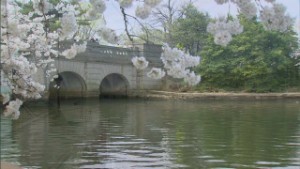Seoul (CNN) -- Amid the war of words and escalating threats emanating from north of the border, for many in South Korea the focus has been on the annual cherry blossom season.
For South Koreans, the arrival of spring guarantees a few things, even in times when headlines echo the threats of conflict: hard-core hikers out in droves, fresh proce in the markets and trees up and down the peninsula blossoming into great swaths of soft pinks and yellows.
Springtime is famed as cherry blossom season and greatly anticipated in a number of cities and towns across South Korea.
Most notable among celebration cities is Jinhae, located a short bus ride outside of Busan along the southeast coast. Here, the annual Jinhae Cherry Blossom Festival commemorates the season's ephemeral beauty.
 Spring arrives with cherry blossoms
Spring arrives with cherry blossomsAn estimated 340,000 cherry trees line Jinhae's streets, rivers and train tracks, and dot surrounding mountainsides.
More than one million South Korean and international visitors attend the festival each year.
The festival originated in 1952 and added the Naval Port Festival to its celebrations in 1963.
Honoring Admiral Yi Sun-Shin, famous for guiding victories against the Japanese during the Joseon Dynasty, the naval festival marks the only time during the year when Jinhae's Republic of Korea Naval Academy campus and Naval Museum are open to visitors. A full-sized replica of the 16th-century turtle ships used by the Admiral are among the displays.
Cherry blossom fans commonly seek photo ops of train tracks beneath a canopy of pink flowers, and around Yeojwa stream and promenade, which is lined with blossoming trees and canola flowers. The latter location was made famous in scenes from the Korean drama "Romance," and has become a hot spot for couples taking photos.
As with most festivals in South Korea, the Jinhae Cherry Blossom Festival can be crowded.
Cheap, abundant, varied and delicious, festival food carts supply a delicious selection of all things fried, grilled and glutinous.
Barbecue chicken on a stick, sausage, grilled squid and octopus, corn on the cob and tteokbokki (rice cakes in spicy sauce) are available for only a few thousand won (a few dollars). More adventurous is beondaegi (boiled silkworm larvae).
A reliable sit-down option at any local restaurant, dolsot bibimbap is a mixture of rice and vegetables topped with an egg and spicy sauce served in a hot stone bowl. It's one of the most satisfying and popular meals around, and goes great with local makgeolli (Korean rice wine).
For visitors, the Jinhae Cherry Blossom Festival makes a memorable day trip.
Direct trains and buses travel to Jinhae from Seoul and Busan. Direct buses from other locations can be limited, though buses connecting through other cities are plentiful. From Changwon, for instance, the local 151 city bus serves Jinhae and travels directly to key festival sites.
Thanks to its southern location, Jinhae's cherry blossoms peak earlier than most in South Korea. The blossoms are expected to end this week.
If you miss the blooms here you might be able to catch them a little further north.
Jinhae-gu, Changwon-si, Gyeongsangnam-do; +82 1899 1111; festival admission is free; 8:30 a.m.-9:30 p.m.; Website


